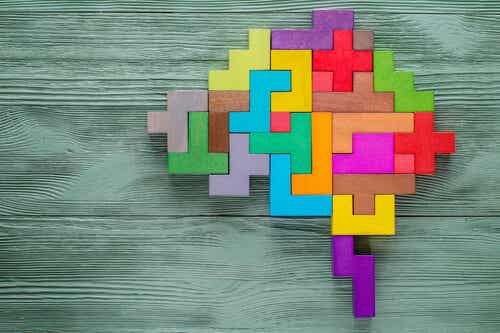Due to its consequences, the condition of alexia could be said to be one of the most extraordinary disorders. The French neurologist Joseph Jules Dejerine first described this disorder in 1881 after studying a patient with a stroke. It manifests itself in a patient’s inability to read after suffering an injury.
It’s important to differentiate alexia from a developmental or learning disorder. In fact, alexia refers to the loss of the ability to read after an injury. In other words, a person who could read perfectly prior to the injury can no longer do so afterward.
It may seem doubtful that this could happen when there’s no damage to the vision. However, reading isn’t limited to one sense. Humans have specific areas of the brain geared to text processing – both in form and content – and their reliability is critical.
Types of alexia
This disorder may manifest along with other neuropsychological conditions. It depends on the type of lesion and on the affected language capabilities. There are four types of alexia:
- Literal (with agraphia). The patient loses the ability to read and write because they can’t recognize letters. This loss corresponds to parietal-temporal lesions of the left hemisphere. In fact, this is the area of the brain that’s primarily involved in language.
- Pure (without agraphia). Subjects can write and recognize letters. However, they fail to put them in sequence to form words.
- Frontal. This occurs mainly in cases of Broca’s aphasia. In this condition, patients manifest ungrammatical and poorly sequenced reading.
- Spatial. This involves deficits in reading due to spatial alterations. It usually appears when there’s a lesion of the right hemisphere. This directly affects the spatial components of reading.
Types of lesions leading to alexia
Functions of the brain aren’t as clearly delimited as countries are on a map. In fact, one lesion can affect various functions. In general terms, alexia appears in the following areas:
- Right temporal-parietal lesion. Leads to alexia and spacial agraphia.
- Left temporal-parietal-lesion. Leads to alexia and global agraphia.
- A temporal-parietal lesion. Leads to alexia without agraphia.
- Damage in a posterior cerebral artery. Produces verbal alexia.
- Damage in the middle cerebral artery (angular branch). Leads to alexia with agraphia.
Main symptoms
Verbal alexia
This type of alexia manifests itself alongside agraphia since the lesion usually occurs at the parietal-temporal level. Thus, the problems reading are evident, both aloud and quietly.
Furthermore, this type of alexia encompasses a general inability to recognize symbolic language codes, such as musical and/or written. Patients might make an effort to write some letters. However, they can’t structure them in an order that allows them to write them down.
Pure alexia
The main characteristic of this type of alexia is that there’s no agraphia. Therefore, the lesioned person maintains their ability to write. Nevertheless, they still experience impairment in this function. In fact, they can write, but they can’t make sense of it.
The lesions are usually occipital and patients can’t articulate the letters of the alphabet even though they can read them.
Third or frontal alexia
As the name suggests, this type usually appears in frontal lesions. In contrast to pure alexia, patients can read some words, but can’t identify the letters that make them up.
For this reason, their writing is usually also deficient, because they skip letters and important grammatical signs.
Spatial alexia
This is a consequence of damage to the right hemisphere, the area responsible for spatial processing. In this type of alexia, patients can’t organize their gaze to focus on reading.
In short, they can’t stay on a line or follow the spatial order of words (from left to right). Furthermore, there’s spatial hemineglect. This means that the patient doesn’t recognize most of the stimuli on the left side.
Possible causes
- Cerebrovascular accidents. Damage or occlusion of the artery results in a lack or excess of blood supply.
- Neurodegenerative diseases. Loss, damage, or degeneration of tissues is a major component of dementias such as Alzheimer’s or Parkinson’s. Alexia is often present in these conditions.
- Tumors. Most brain tumors pressure and alter brain metabolism. Hence, they cause tissue damage.
- Craniocerebral trauma. Accidents and blows that cause damage to any of the above-mentioned structures may result in reading impairment.
Diagnosis
Diagnosis depends on the area in which the damage or lesion occurs. On this basis, neurologists and neuropsychologists will conduct specific screening tests. They usually consist of reading, naming, and spatial order tasks.
- The physician will first conduct tests in an attempt to stipulate to what degree the patient’s reading ability is affected. They’re quick and general tests, intended to provide clues to symptoms.
- Specific: Depending on the type of lesion and the results of the screening tests, the physician will conduct specific tests to determine the type of alexia.

Treatment
This is usually multidisciplinary in nature. In fact, strategies include work carried out by various professionals. These might be psychologists, speech therapists, neurologists, and neuropsychologists. While the identified brain damage is always permanent, medical intervention facilitates new strategies. This means the patient can recover the highest possible functionality. To this end, clinicians must adapt any intervention to the individual circumstances of every patient. Naturally, these must be carried out within the recommended guidelines and protocols.
Cognitive stimulation and psychoeducation are two of the most frequent ingredients in successful interventions. Furthermore, all interventions share the objective of the patient to become self-sufficient within their own environment.
Technological advances have made it possible for clinicians to address this disorder more efficiently with apps and the use of virtual reality therapy. Nevertheless, any health professional or a person close to a patient with alexia should also try putting themselves in their shoes. For instance, they should look at a word and imagine what it must be like to not be able to read it. In this way. they’ll be able to empathize and better understand how the patient thinks and feels as a result of this disabling condition.
Did You Know There Are Different Types of Dyslexia?
https://lamenteesmaravillosa.com/alexia-la-incapacidad-adquirida-de-leer/
The post Alexia, The Loss of the Ability to Read appeared first on Exploring your mind.



















Comments